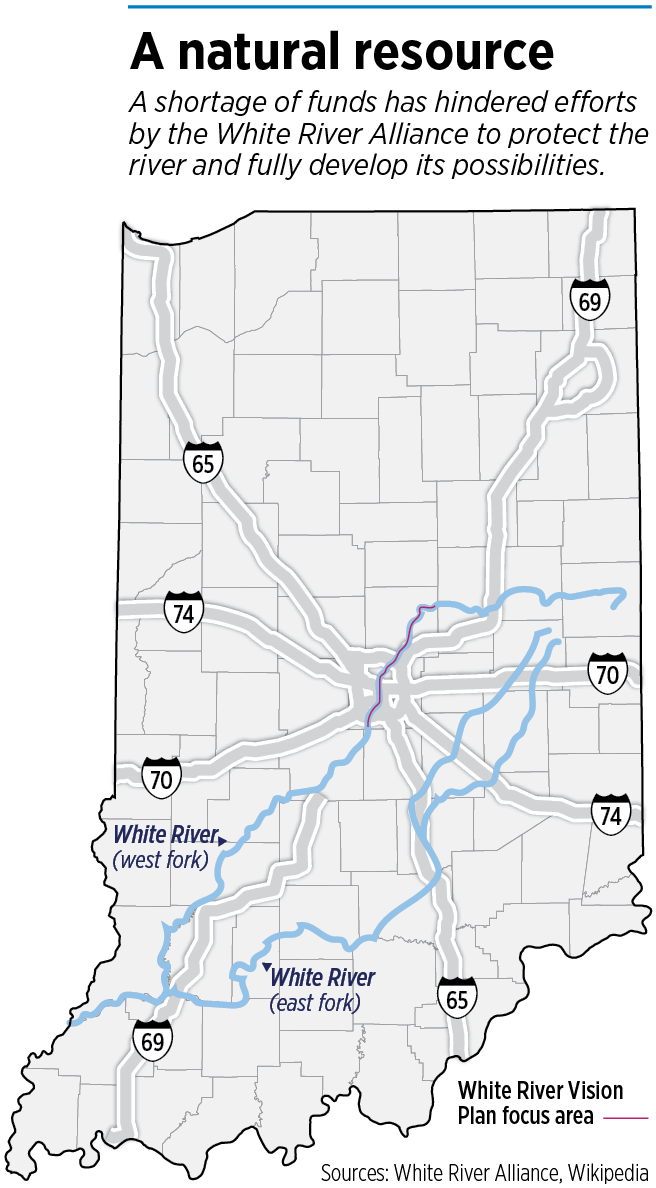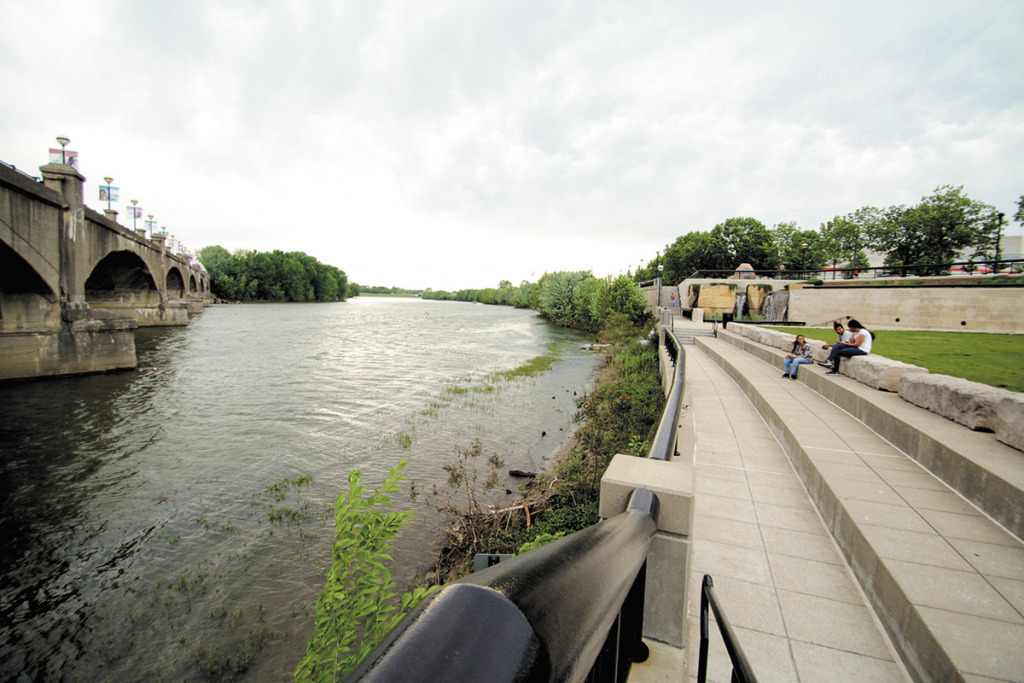Subscriber Benefit
As a subscriber you can listen to articles at work, in the car, or while you work out. Subscribe NowImproving a 58-mile stretch of the White River and taking advantage of the natural resource that flows through the Indianapolis area has been on local leaders’ wish list for years.
In 2019, community leaders unveiled the White River Vision Plan, which detailed how the waterway could be preserved and developed through Marion and Hamilton counties. The 222-page plan was years in the making and included recommendations for commercial development, historic districts, cultural destinations and program opportunities.

No price tag was attached, but officials know hundreds of millions of dollars would be necessary to turn the vision into reality, and that has been a barrier toward making significant progress.
Brad Beaubien, director of destination development for Visit Indy, said the goal is to create a national-park-like attraction with more year-round usage and more public access points, trails and spaces. The vision also outlines a strategy for improved water quality and reduced stormwater runoff.
Some progress has been made, such as the $11 million the city of Indianapolis plans to invest in Riverside Park as part of a $120 million master plan for the attraction, the proposed new family center at Broad Ripple Park and the White River Bluffs Nature Preserve that is in the works.
In Hamilton County, an effort among Conner Prairie, Hamilton County Parks and Recreation, and Carmel Clay Parks and Recreation to build a bridge connecting the east and west sides of the river, develop an education center, create a farm-to-fork experience, reintroduce wetlands and add trails, and more opportunities for canoeing and kayaking would cost about $200 million.

“The vision plan carries no small price tag, but the amount of economic energy it could create is also significant,” Hamilton County Tourism Inc. President and CEO Brenda Myers said.

But even if the state allocated only $1 billion of its $3 billion American Rescue Plan allotment to the White River, Beaubien and Myers said that would be enough to create an amenity on the level of a national park.
“By putting that money in upfront, no pun intended, the ripple effect is going to be extraordinary,” Myers said.
The investment could be used to build more parks along the waterway, cover the costs of mitigation efforts, create more public-access points, establish community programming and build alternative dam structures.
Myers said an investment in the White River could be viewed as an infrastructure project, because the waterway is critical to the state’s ecosystem and water supply.
Beaubien said some ideas in the White River Vision Plan need initial design and engineering funding to determine their feasibility.
“Do you spend money on design for something that may not happen for 10 or 15 years, or do you spend it on fixing something that you know needs [to be] fixed now?” he said. “That’s the struggle that many of our local government entities are facing.”
Even with an initial infusion of big money, the national-park-like attraction would still need an entity to manage it, and that would require ongoing funding.
“It’s great to think about this one-time infusion of cash, because we have this amazing opportunity,” Beaubien said. “But that doesn’t absolve us of this requirement that we have to fix the structural challenges of how we fund this or any other place-making amenity regionally and keep it going. We have to do both.”•
To return to the main story, click here.
Please enable JavaScript to view this content.


$1 billion of the state’s $3 billion American Rescue Plan allotment shouldn’t be used for a White River Park capital project.
All of those American Rescue Plan funds instead need to be used to benefit the entire state, not just the special interests in Indianapolis
The funds come from taxpayers throughout the state, not just Indianapolis.
The Indianapolis MSA contains a little over 30% of Indiana’s population and is responsible for more than 40% of Indiana’s GDP. The Indianapolis MSA should get at least $1.2b of the money.
Improving White River as well as other waterways is a great idea that will need a significant amount of planning and funding. The waterways could become popular green spaces for recreation and, essentially, extensions of White River State Park. A comprehensive plan is needed before funds are requested.
However, a key and costly aspect is creating flows that ensure a pleasant waterway rather than a sandbar-riddles channel with unsightly overgrowth. Fall Creek between Geist Reservoir and its confluence with White River once was a relatively fast flowing waterway; it is currently an eyesore at Meridian Street and elsewhere due to the severely diminished flow that may be attributable to not only water storage in Geist but an apparent objective to ensure luxurious lakefront views specific water levels to please adjacent property owners (to the disbenefit of downstream uses, views, flora and fauna).
Given that, what infrastructure elements can be implemented to, at the very least, return Fall Creek to a reasonably attractive waterway, one that would provide an attractive amenity. And how much would initial capital and ongoing maintenance costs be and by whom would they be borne. Ditto for Whiter River improvements. Again, a great idea. A network of parks and trails and pathways extending through Hamilton and Marion Counties with links to nearby park would be fantastic.
Yet, this does not seem to meet the overarching objective of the American Rescue Plan which is to stimulate the economy, increase meaningful employment, and initiate key actions to restore integrity and repair or replace decrepit infrastructure throughout the nation. Unfortunately, US infrastructure is much worse than that of peer nations in Europe and Asia and the Arabian Peninsula. The US has historically devoted capital $$$,$$$,$$$ to building infrastructure but subsequently has done far too little to maintain and improve it once built. Nothing lasts forever. And, all in Congress continue to play games to ensure their personal longevity with little true action to get things moving — i.e. achieve real improvements for the average citizen.
Derek — I doubt the flow rate in Fall Creek has changed. Besides Geist, Fall Creek is also controlled at the Keystone dam / water treatment plant and there used to be a low head dam just east of the DMLK Bridge that created an upstream pool near Meridian. That was removed sometime around 2007-08 and has created a more natural condition for the creek. That, unfortunately, has also created an opening for invasive species like Asian bush honeysuckle to take over, which is probably what you’re describing as unsightly. More should be done to try to control the honeysuckle and other invasive species, but there’s isn’t a plot to keep extra water in Geist.
I would much rather have the honeysuckle, etc., then the grounded couches, old tires, mounds of trash, burnt up trailers, remnants of tents and tarps, and so on. That is the river view from the zoo south, all the way to the southern end of the bike trail Before we spend money dolling it up, lets clean it up, and see if we can keep it that way. It all flows downstream, in more ways then one.
The White Water River Vision was being promoted a couple of years ago and had pretty detailed ideas of feature and amenities that could be added. I was at several public meetings in Hamilton County related to the planning and it seemed well done. That information should be publicly available.
Invasive plants stop the growth of native species and do not benefit humans or the environment!
This subject comes up every so often. The White River is a disgrace but it will never be taken care of in a city as tax-averse as Indy and a state as tax-averse as Indiana.
The White River (and Fall Creek for that matter) has tremendous potential and could transform the very image of Indy…but it will stay a literal Sh*t’s Creek because the Right People can’t figure out a cheap way to make money off of it locally.